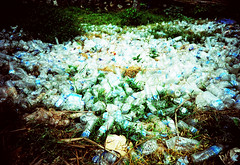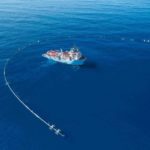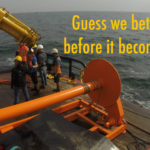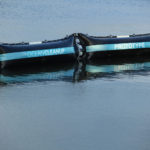
This is a post in appreciation of Blog for Action Day’s 2010 theme – Water. People are made mostly of water and thus we need to replenish ourselves, creating a voracious thirst. This is the thirst of nearly 6 billion people on this planet. We also share this thirst with trillions more plants and animals.
There is much uncertainty in our water supply these days. From pollution to disease-causing microbes, humans somehow began to mistrust their water. In order to ensure safe supply, companies began selling pristine water in bottles guaranteeing proper filtration. Thu the culture of the water bottle was born
Merriam-Webster’s defines disease from the Latin as “lack of comfort”. This perfectly describes the relationship that humans have with water. We have a natural fear of it. In high doses, water can kill you. Water can be a vector for pathogens. We are not well-adapted for an aquatic lifestyle and perhaps those organisms that are might want to eat us when we are out of our natural element. We are not very comfortable with water, despite our innate attraction to living close to it and being smothered by it. So we do what humans have been doing for centuries when we are afraid, imprison and keep control of our fear.
It seems so simple and elegant at face value. What harm is there in a bottle of water. Our bodies need water, and bottling it is a convenient way to carry it around. Bottled water is quite ingrained in our society now. You can go anywhere and buy a bottle of water. Some restaurants won’t even serve you water from the tap anymore. It really isn’t so bad is it? The water itself is fine, in most cases. It’s what we do with the byproduct of our plastic water bottle driven society that is likely the symptom of a much grander scale epidemic. Much as a virus or bacterial infection kills its host for its immediate needs, we essentially sacrifice our own planet for the sake of convenience.
The first stage in disease prevention is recognizing the symptoms. We must dive deeper into the reasons why we mistrust water. Much of the harmful impurities in our water supply have to do with our historical mistreatment of it. We have spent centuries polluting water just about every way we possibly could, affecting mineral content, chemistry and pH, tainting it with radioactive and pharmaceutical waste, and entirely restructuring the aquatic communities of plants and animals. Not only have we affected the water itself, but we’ve also re-engineered and obstructed waterways, introduced foreign plants and animals, and completely drained lakes and rivers in arid regions because of our insatiable consumption. Just creating the bottled water product is a test in contradictions itself. It is estimated that nearly 7 times the amount of water in the bottle is used to create and transport the product to market.
The second step in disease prevention is to seek out treatment once symptoms have been recognized. This is often the most difficult step, involving much courage. Over the last couple decades there have been many courageous individuals crusading for better water. Some cities have even taken steps to protect vital watersheds. Governments have enacted legislation to protect waterways and give minimum standards for water treatment that providers must follow. But there is clearly a long way to go. Activism by the public and businesses, who are the end users of all water services, is needed now more than ever. Businesses can take it even further by applying their financial weight and creating incentives for water quality and plastic reduction. Governments can help businesses by giving tax breaks or other incentives for utilizing technology that keeps water clean, reduces input of waste into waterways, reduces or eliminates use of plastic water bottles in the workplace or provides public awareness of issues pertaining to water quality and plastic pollution. The ideas certainly don’t stop there, but there is no shortage of things that COULD be done, and quite affordably – at times even saving us all money!
The third step in disease prevention is immunization. Treatment is not enough, a cure needs to be found and the population needs to be protected against further symptoms. We will never be able to undo the damage we’ve done in terms of plastic water bottle pollution. It is impossible to try to find every water bottle and clean it up. Even if we could, we would be disposing of them in a landfill where the plastic will degrade and chemicals will leach out into the water table or the broken down pieces of plastic will find their way into world through weathering of the garbage heaps over time. But we have the CHOICE to stop our behavior and not exasperate the situation further. If we keep adding to the input, the damage will never lessen. Only we can immunize ourselves this time.
Finally, the last step is promoting awareness of the disease. This step involves taking back our tap. Water quality and taste tests often find out that bottled water is no different from city water. In fact, most of the time bottled water IS tap water that has just been run through a filter. Many of you already have filters in your home for tap water. If you don’t, get one. $15 for a filter attachment and $5 every three months for a new filter will save you money in the long run. This is around $35-40 a year for clean tasty tap water. That less than buying one bottle of water a week. I’m sure you are probably buying more than that. Get yourself a nice, chic Sigg bottle or save yourself some money and get a cheap aluminum bottle from the discount store. They are durable, washable and can hold your beloved liquid for years without fail. Mine has a D-clip so I can attach it to my man-purse laptop bag. But most importantly, make sure you are vigilant about water quality in your area. Your water company should provide you with regular water quality reports – read these. Often they are well under EPA guidelines. Keep a fire under their bums, it is up to us to be responsible for what we consume. If your area is exceeding EPA guidelines there are many environmental law firms that will make life very uncomfortable for local government and water utilities until they get their act together. We have the law on our side in water quality cases.
I highly recommend watching this very well done video by the Story of Stuff Project that puts the entire process into perspective.
Much more on PLASTIC at Deep Sea News.






amen! this issue of bottled water is WAY worse in much of europe, especially italy.
Canada I think now has the best recycle program